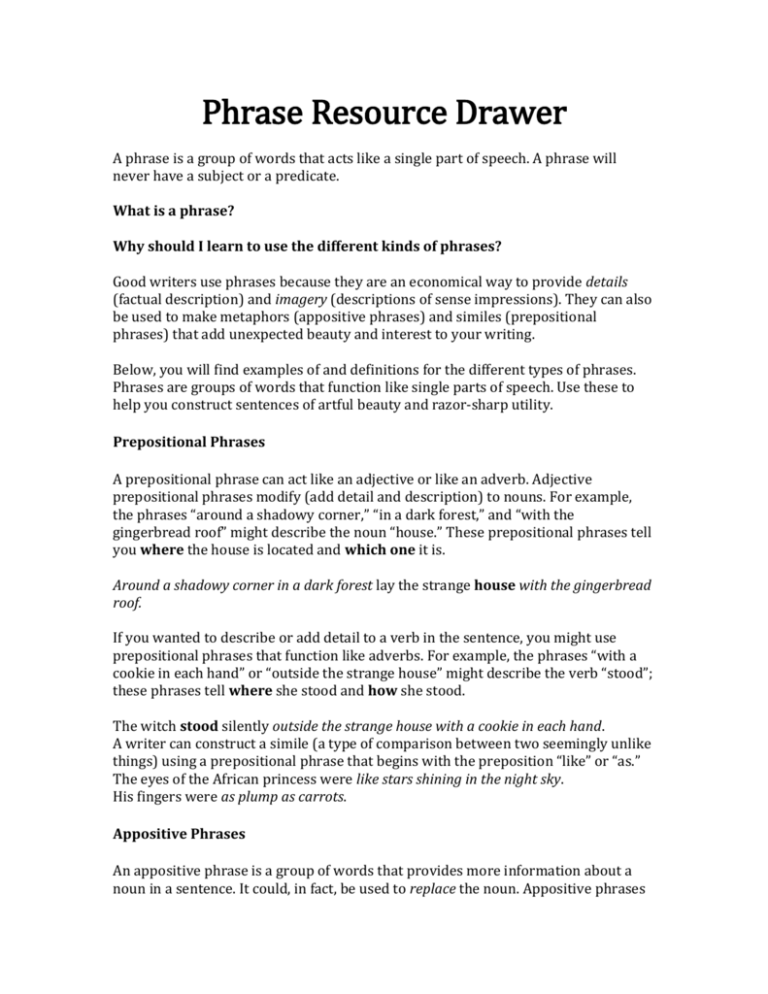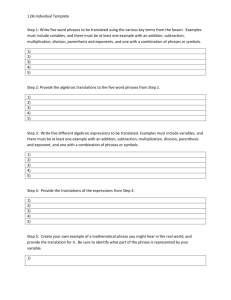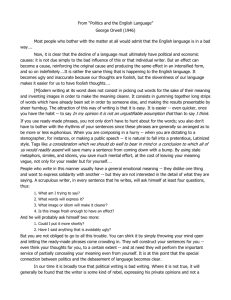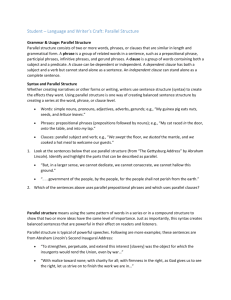File
advertisement

Phrase Resource Drawer A phrase is a group of words that acts like a single part of speech. A phrase will never have a subject or a predicate. What is a phrase? Why should I learn to use the different kinds of phrases? Good writers use phrases because they are an economical way to provide details (factual description) and imagery (descriptions of sense impressions). They can also be used to make metaphors (appositive phrases) and similes (prepositional phrases) that add unexpected beauty and interest to your writing. Below, you will find examples of and definitions for the different types of phrases. Phrases are groups of words that function like single parts of speech. Use these to help you construct sentences of artful beauty and razor-sharp utility. Prepositional Phrases A prepositional phrase can act like an adjective or like an adverb. Adjective prepositional phrases modify (add detail and description) to nouns. For example, the phrases “around a shadowy corner,” “in a dark forest,” and “with the gingerbread roof” might describe the noun “house.” These prepositional phrases tell you where the house is located and which one it is. Around a shadowy corner in a dark forest lay the strange house with the gingerbread roof. If you wanted to describe or add detail to a verb in the sentence, you might use prepositional phrases that function like adverbs. For example, the phrases “with a cookie in each hand” or “outside the strange house” might describe the verb “stood”; these phrases tell where she stood and how she stood. The witch stood silently outside the strange house with a cookie in each hand. A writer can construct a simile (a type of comparison between two seemingly unlike things) using a prepositional phrase that begins with the preposition “like” or “as.” The eyes of the African princess were like stars shining in the night sky. His fingers were as plump as carrots. Appositive Phrases An appositive phrase is a group of words that provides more information about a noun in a sentence. It could, in fact, be used to replace the noun. Appositive phrases that follow or precede a noun provide a richer description for the reader than if the writer had simply used the noun by itself. Appositive phrases act like nouns. Most of the time, appositive phrases are nonrestrictive (in other words, the sentence would function perfectly well without them), so they are most often surrounded by commas, indicating that these phrases are parenthetical, or extra. Examples: Oliver Cranberry, a tall, skinny basketball player with one blue and one brown eye, stepped into the path of a truck hurtling down the road at seventy miles per hour. A tall, skinny basketball player with one blue and one brown eye, Oliver Cranberry stepped into the path of a truck hurtling down the road at seventy miles per hour. My dog, a scruffy mutt with an engaging grin, met me at the door with his leash in his mouth. A strapping giant of a man with vivid tattoos all over his arms, the circus performer strutted down Main Street at the head of the parade. Appositive phrases like the following ones can also be used to construct metaphors (comparisons that do not use the words “like” or “as”). The giant pine tree, sentinel of the forest, stood guard in the frosty night. The huge city, an anthill of human activity, sprawled in the distance as the plane approached. Gerund Phrases Gerund phrases act like nouns, and they can do anything a noun can do. They can serve as the subjects of sentences or clauses, and they can serve as the object of a verb or of a preposition. They always start with a verb form that ends in “ing.” The strange thing about gerunds is that they are formed from verbs, but they don’t act like verbs. They act like nouns. Examples: Subject of the sentence: Swinging through the trees is an activity only Tarzan could feel comfortable doing. Object of the verb: Jemima hates swimming in the morning. Object of a preposition: I am really not interested in studying calculus for the rest of my life. Participial Phrases Participial phrases can look a lot like gerund phrases, but they don’t act like nouns; they act like adjectives. Participles are also verb forms, just as gerunds are. But they behave like adjectives. Participles can take past or present forms. Past participial phrases: Parked in a loading zone, mom’s car was demolished by a delivery truck. Although “parked in a loading zone” might look like a verb phrase, it’s really acting like an adjective, describing “mom’s car.” The VERB in the sentence is “was demolished.” Exhausted from the battery of standardized tests, Jim collapsed in front of the TV after school. Eliza, elated by the prospect of going to the prom with Poindexter, began designing her corsage. Present participial phrases: Swinging through the trees, Tarzan sped through the jungle to rescue Jane. Munching the delightful fresh apricots, Jennifer read War and Peace in the orchard. Infinitive Phrases Infinitive phrases are easy to spot. They always start with the word “to” plus a verb; for example, “to swim,” “to love,” “to quit,” “to ride,” etc. The word “to” plus a verb is called an infinitive. Infinitive phrases include the infinitive and any words or phrases that modify the infinitive. Infinitive phrases act like nouns. They usually don’t serve as the objects of prepositions, though they often act as subjects of sentences and objects of verbs. Examples: To swim in the sunshine is one of the pleasures of summer vacation. In this case, the infinitive phrase serves as the subject of the sentence. In the summer, I love to swim in the sunshine. In this case, the infinitive phrase is the direct object of the verb. What do you love? I love this thing: to swim in the sunshine. Absolute Phrases An absolute phrase is composed of a noun plus an adjective or a participle, plus any modifiers that describe the noun or adjective. An absolute phrase is really a tool of concision, allowing the writer to embed a full thought into a phrase that is almost a clause. Basically, to make the absolute phrase, the writer just removes a “to be” verb from the clause. Example: Two independent clauses: “Her expression was dejected. Sarah trudged into the room.” One of the clauses compressed into an absolute phrase: “Her expression dejected, Sarah trudged into the room.” His face was red with embarrassment. Henry withdrew from the room His face red with embarrassment, Henry withdrew from the room. Her eyes were shining with delight. Polly opened the gift. Polly, her eyes shining with delight, opened the gift. One of the best ways to use absolute phrases is in triads, or groups of three. Observe the following examples: Its tiny wings outstretched, its little voice peeping urgently, its orange feet pattering through the muddy grass, the baby duck ran toward its mother. Here’s another way to do it... The baby duck ran toward its mother, its tiny wings outstretched, its little voice peeping urgently, its orange feet pattering through the muddy grass. Or, you could do a subject/verb split! The baby duck, its tiny wings outstretched, its little voice peeping urgently, its orange feet pattering through the muddy grass, ran toward its mother. WHICH ORDER BEST FITS YOUR WRITERLY PURPOSE? WHAT RHETORICAL EFFECT RESULTS FROM YOUR CHOICES? Comma/Punctuation Cheat Sheet 1. Use a comma before a coordinating conjunction that connects two independent clauses. An independent clause is a group of words that can stand alone as a sentence; like any clause, it has both a subject and a verb. A coordinating conjunction is one of the following words: for and nor but or yet so 2. There are three ways to connect two independent clauses. Below are two independent clauses. Alex is a good writer. He writes vividly about his experiences. The first way is to insert a comma and a coordinating conjunction between the two clauses. Alex is a good writer, and he writes vividly about his experiences. The second way is to insert a semicolon between the two clauses. Alex is a good writer; he writes vividly about his experiences. The third way is to insert a semicolon, a conjunctive adverb like “however” or “therefore” or “thus,” and a comma between the two clauses. Alex is a good writer; moreover, he writes vividly about his experiences. 3. After an introductory group of words and before the subject of the main clause, use a comma. Insert a comma between an introductory subordinate clause and the subject of the next independent clause. Note: a subordinate clause is a group of words that has both a subject and a verb, but it begins with a subordinating conjunction like “because,” “although,” or “since,” and so it cannot stand alone as a sentence. Because Alex is a good writer, he writes vividly about his experiences. Although Poindexter broke his glasses, he was still able to complete the test. Although the elephant had lost its tooth, it still ate Albert. Insert a comma after two or more consecutive prepositional phrases. In the castle of the monster with the enormous shoes, a beautiful goldfish wept bitterly. Insert a comma after an introductory participial phrase. Shivering with anticipation, Poindexter entered the palace of video games. Insert a comma after a long introductory element of any kind! Simple sentence: One independent clause. Notes on Types of Sentences The silly goldfish swirled stylishly around the frozen pond. Compound sentence: Two or more independent clauses Albert burped; he had eaten fourteen pieces of pizza, and he had violent indigestion. Johann entered the arena ready to rumble; he had his favorite Frisbee in his hand. Complex sentence: ONLY one independent and AT LEAST one subordinate clause. When Poindexter saw the math test in the teacher’s hand, he leapt into the air with joy because he loved competing with his classmates. Although Brenda was unattractive, she was extremely amusing. Compound-Complex Sentence: At least TWO independent clauses and at least ONE subordinate clause. If you want to be an astronaut, you must learn calculus, and you must also be physically fit.








